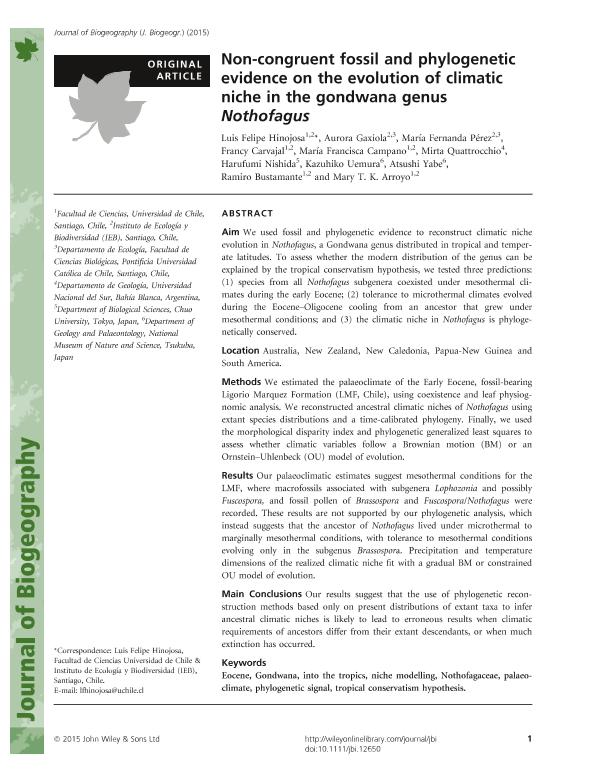Artículo
Non-congruent fossil and phylogenetic evidence on the evolution of climatic niche in the Gondwana genus Nothofagus
Hinojosa, Luis Felipe; Gaxiola, Aurora; Pérez, María Fernanda; Quattrocchio, Mirta Elena ; Carvajal, Francy; Campano, María Francisca; Nishida, Harufumi; Uemura, Kazuhiko; Bustamente, Ramiro; Arroyo, Mary T.K.
; Carvajal, Francy; Campano, María Francisca; Nishida, Harufumi; Uemura, Kazuhiko; Bustamente, Ramiro; Arroyo, Mary T.K.
 ; Carvajal, Francy; Campano, María Francisca; Nishida, Harufumi; Uemura, Kazuhiko; Bustamente, Ramiro; Arroyo, Mary T.K.
; Carvajal, Francy; Campano, María Francisca; Nishida, Harufumi; Uemura, Kazuhiko; Bustamente, Ramiro; Arroyo, Mary T.K.
Fecha de publicación:
03/2016
Editorial:
Wiley Blackwell Publishing, Inc
Revista:
Journal of Biogeography
ISSN:
0305-0270
Idioma:
Inglés
Tipo de recurso:
Artículo publicado
Clasificación temática:
Resumen
Aim: We used fossil and phylogenetic evidence to reconstruct climatic niche evolution in Nothofagus, a Gondwana genus distributed in tropical and temperate latitudes. To assess whether the modern distribution of the genus can be explained by the tropical conservatism hypothesis, we tested three predictions: (1) species from all Nothofagus subgenera coexisted under mesothermal climates during the early Eocene, (2) tolerance to microthermal climates evolved during the Eocene-Oligocene cooling from an ancestor that grew under mesothermal conditions; and (3) the climatic niche in Nothofagus is phylogenetically conserved. Location: Australia, New Zealand, New Caledonia, Papua-New Guinea and South America. Methods: We estimated the palaeoclimate of the Early Eocene, fossil-bearing Ligorio Marquez Formation (LMF, Chile), using coexistence and leaf physiognomic analysis. We reconstructed ancestral climatic niches of Nothofagus using extant species distributions and a time-calibrated phylogeny. Finally, we used the morphological disparity index and phylogenetic generalized least squares to assess whether climatic variables follow a Brownian motion (BM) or an Ornstein-Uhlenbeck (OU) model of evolution. Results: Our palaeoclimatic estimates suggest mesothermal conditions for the LMF, where macrofossils associated with subgenera Lophozonia and possibly Fuscospora, and fossil pollen of Brassospora and Fuscospora/Nothofagus were recorded. These results are not supported by our phylogenetic analysis, which instead suggests that the ancestor of Nothofagus lived under microthermal to marginally mesothermal conditions, with tolerance to mesothermal conditions evolving only in the subgenus Brassospora. Precipitation and temperature dimensions of the realized climatic niche fit with a gradual BM or constrained OU model of evolution. Main Conclusions: Our results suggest that the use of phylogenetic reconstruction methods based only on present distributions of extant taxa to infer ancestral climatic niches is likely to lead to erroneous results when climatic requirements of ancestors differ from their extant descendants, or when much extinction has occurred.
Archivos asociados
Licencia
Identificadores
Colecciones
Articulos(INGEOSUR)
Articulos de INST.GEOLOGICO DEL SUR
Articulos de INST.GEOLOGICO DEL SUR
Citación
Hinojosa, Luis Felipe; Gaxiola, Aurora; Pérez, María Fernanda; Quattrocchio, Mirta Elena; Carvajal, Francy; et al.; Non-congruent fossil and phylogenetic evidence on the evolution of climatic niche in the Gondwana genus Nothofagus; Wiley Blackwell Publishing, Inc; Journal of Biogeography; 43; 3; 3-2016; 555-567
Compartir
Altmétricas



